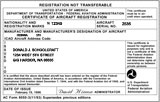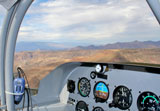|
Experimental Flight TestGeneralFAR 91.319(b) requires that an unproven aircraft be assigned to a experimental flight test area. The assigned flight test area is prescribed in accordance with FAR 91.305. The FAA, when requested, will assist applicants in selecting areas that comply with FAR 91.305. The FAA is required to evaluate each application to determine that the flight test area does not exceed that which is reasonably required to accomplish the program. Assigned Experimental Flight Test AreasUnder FAR's 91.319(b) and 91.305, all initial flight operations of experimental aircraft must be limited to the assigned experimental flight test area until the aircraft is shown to be controllable throughout its normal range of speeds and all maneuvers to be executed, and has not displayed any hazardous operating characteristics. In the case of the first flight of an aircraft from an airport surrounded by a densely populated area, the FAA will ensure that there is a flight corridor that subjects the least number of persons and property to possible hazards. In addition, after leaving the airport, the aircraft will be required to operate from an outlying airport until its controllability and safety are established. The aircraft may return to its base after that, but must continue to use the established corridor for subsequent operations. A description of the corridor must be made a part of the operating limitations. Please note that If there is not an acceptable corridor for approach and departure, the FAA will deny the application for airworthiness certificate. If this happens, you will need to relocate the aircraft by other means to a suitable airport. NOTE: An acceptable approach/departure corridor exists when the corridor provides reasonable opportunity(s) to execute an off-airport emergency landing that will not jeopardize other persons or property. Operation Within Assigned Experimental Flight Test AreasExcept for amateur-built aircraft, there are no specific flight time requirements for operation within an assigned flight test area. Each case must be judged on the individual conditions, such as the type and complexity of the aircraft. For example, flight testing in conjunction with an STC modification may require only 1 hour in an assigned flight test area while the initial operation of a prototype jet aircraft or a military surplus jet aircraft may require 20 or more hours before the requirements of FAR 91.319(b) can be met. The FAA will not amend the operating limitations to permit flight outside of the assigned flight test area until the applicant certifies and the FAA finds compliance with FAR 91.319(b). This finding by the FAA may be a review of the aircraft records containing a statement by the pilot that the aircraft is controllable throughout its normal range of speeds and throughout all of the maneuvers to be executed, and has no hazardous operating characteristics or design features. Also, the maintenance history while in the test area must be satisfactory. The FAA may witness flights or inspect the aircraft if deemed necessary. The Production Certificate (PC) or Approved Production Inspection System (APIS) holder may show compliance with FAR 91.319(b) in accordance with its FAA-approved experimental operating procedure. AerobaticsAerobatic maneuvers may be permitted while the aircraft is in the assigned flight test area if, in the FAA’s judgment, the aircraft has the capability of such flight. However, these maneuvers should not be attempted until sufficient flight experience has been gained to establish that the aircraft is satisfactorily controllable. Aerobatic maneuvers that have been demonstrated in the assigned flight test area should be documented in the aircraft records. Only those aerobatic maneuvers that have been successfully accomplished should be permitted after leaving the assigned flight test area. Those aircraft owners/operators wishing to include new aerobatic maneuvers will need to make a request for a new flight test area. Operating Outside Experimental Flight Test AreasLight-sport aircraft that have been issued a special flight permit for flight testing may be operated outside of an assigned flight test area once they have met those specific requirements. Except for research and development, operation of the aircraft outside an assigned flight test area will require issuance of a new experimental airworthiness certificate with new amended operating limitations. Before authorizing an aircraft to operate outside of an assigned flight test area, the FAA will ensure the requirements of FAR 91.9 have been satisfied and are available in the aircraft. Except for amateur-built aircraft, if any major changes are made to an aircraft after it has been certificated for operation outside of a previously assigned flight test area, the cognizant FAA office must be notified. After the FAA offices have been notified and a determination is made that the aircraft needs to return to a experimental flight test area, an amended certificate should be applied for with new limitations as needed. A new Form 8130-7 is required whenever operating limitations are amended, because the date of the old limitations on the corresponding certificate would not be the same as the date of the new limitations.
Go from this Experimental Flight Test Page back to the Experimental Airworthiness Certificates Page |









